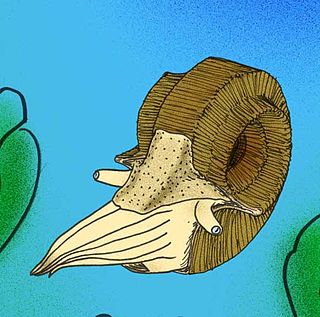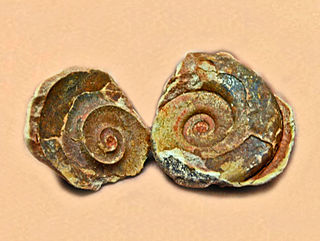Related Research Articles

Ammonoids are a group of extinct marine mollusc animals in the subclass Ammonoidea of the class Cephalopoda. These molluscs, commonly referred to as ammonites, are more closely related to living coleoids than they are to shelled nautiloids such as the living Nautilus species. The earliest ammonites appeared during the Devonian, and the last species either vanished in the Cretaceous–Paleogene extinction event, or shortly after, during the Danian epoch of the Paleocene.

The Early Triassic is the first of three epochs of the Triassic Period of the geologic timescale. It spans the time between 251.902 Ma and 247.2 Ma. Rocks from this epoch are collectively known as the Lower Triassic series, which is a unit in chronostratigraphy.

In the geologic timescale, the Olenekian is an age in the Early Triassic epoch; in chronostratigraphy, it is a stage in the Lower Triassic series. It spans the time between 251.2 Ma and 247.2 Ma. The Olenekian is sometimes divided into the Smithian and the Spathian subages or substages. The Olenekian follows the Induan and is followed by the Anisian.

The Induan is the first age of the Early Triassic epoch in the geologic timescale, or the lowest stage of the Lower Triassic series in chronostratigraphy. It spans the time between 251.902 Ma and 251.2 Ma. The Induan is sometimes divided into the Griesbachian and the Dienerian subages or substages. The Induan is preceded by the Changhsingian and is followed by the Olenekian.
Agathiceras is a subglobose goniatitid from the family Agathiceratidae, widespread and locally abundant in Lower Pennsylvanian to Middle Permian sediments, e.g. the Urals, Sicily, and Texas.
Anatsabites is a monospecific genus of ammonoid cephalopods belonging to the Atsabitidae family. Only species is Anatsabites multiliratus, formerly placed into genus Paraceltites. Its fossils were found in Wordian (Permian) of Texas.

Araxoceras is an extinct genus of ceratitid ammonites that lived in the Late Permian marine environments of Iran, South China and Japan. The various species had distinctive, angular-cornered shells.
Aristoceratoides is an extinct ammonoid genus belonging to the goniatitid family Thalassoceratidae that lived during the Middle Permian. Named by Ruzhentsev, 1960, the type species is "Thalassoceras" varicosum Gemmellaro, 1887.
Yinoceras is a genus of middle Permian goniatitid ammonite, the type genus for the subfamily Yinoceratinae of the family Pseudohaloritidae.

Xenodiscoidea, formerly Xenodiscaceae, is a superfamily within the ammonoid order Ceratitida. The superfamily was named by Frech in 1902, presently contains ten families, only one of which was included in the original Otocerataceae of Hyatt, 1900, the remaining having been added.
Paraceltitidae is a family of Middle and Upper Permian cephalopods, that comprise the earliest of the Ceratitida. Paraceltitidids have variably ribbed, discoidally evolute shells with compressed elliptical whorl sections and simple suture lines. Their origin is most likely in the Daraelitidae of the Prolecanitida and they are the apparent source of the Xenodiscidae. All together they lived for some 12 million years, from about 270.6 to about 258 million years ago.
Adrianitidae is a family in the Adrianitaceae, a superfamily of ammonites in the cephalopod order, Goniatitida, known from the Middle Pennsylvanian to the Middle Permian.
Hoffmanniinae is an adrianitid ammonoid cephalopod subfamily established for the Middle Permian genus Hoffmannia.
Shouchangoceras is a genus of goniatitid pseudohaloritid ammonoids and is the type genus for the pseudohaloritid subfamily Shouchangocerinae. The genus is characterized by a compressed shell as much as 5 cm in diameter, with a strongly constricted mature peristome that has shallow dorsolateral sinus, a moderately deep rounded ventral sinus, but without conspicuous lappets, and ornamented by moderately strong transverse ribs and numerous stronger longitudinal lirae, producing a weakly reticulate pattern. Lobes are attenuate. The siphuncle is within the dorsal septal flecture.
Cibolites is a genus of ammonoid in the family Paraceltitidae of the cephalopod order Ceratitida which lived during the Late Permian. The genus was first found the Texas and Mexico. The shell is similar to that of Xenodiscites but smooth and with goniatitic sutures.

Paraceltites is a genus of ammonoid cephalopods in the ceratitid family Paraceltitidae, known from the Middle and Upper Permian of Sicily, the Alps, Crimea, Texas and Mexico. The shell of Paraceltities is evolute with whorls compressed, venter arched and smooth, sides bearing ribs that slant somewhat forward dorso-ventrally. The suture is simple and goniatitic.
Kingoceras is a genus of ammonoids in the order Ceratitida and family Paraceltitidae which lived during the Late Permian from about 265 to about 254 million years ago. The shell is thinly lenticular, sutures are goniatitic and have only eight fully distinct lobes.
Doulingoceras is a genus of ammonoid within the ceratitid order, found in China, that lived during the Late Permian during the time span from about 260.5 to 254 million years ago. The genus is included in the family Paraceltitidae, which belongs to the superfamily Xenodiscaceae.
Meitianoceras is a genus of ammonites in the ceratitid family Paraceltitidae that lived during the final stage of the Permian, from about 254 to 251 million years ago. The shell of Meitianoceras is small and evolute. All whorls being clearly visible. The outer rim (venter) is angular. The surface of the shell has growth lines or plications. The suture is of the Paraceltites type with 8 unserrated lobes and long, anteriorly, contracted club-shaped external saddles.
Liostrea is a genus of extinct oysters, marine bivalve mollusks in the family Gryphaeidae.
References
- ↑ SPINOSA, Claude; FURNISH, W. M.; GLENISTER, Brian F. The Xenodiscidae, Permian ceratitoid ammonoids. Journal of Paleontology, 1975, 239-283.
- ↑ "Goniat database - Paraceltitidae" . Retrieved 3 February 2019.